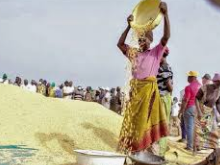According to the United States Department of Agriculture (USDA), domestic milled rice production is forecasted to go up by 18 percent from last year’s estimated production to reach 900,000 metric tonnes (MT).
USDA’s prediction is based on expectations of improved weather conditions and assumes that farmers will give greater consideration to the Ghana Meteorological Agency’s (GMET) seasonal weather forecasts when planning their activities.
The Department has also forecasted rice imports for marketing year 2025/2026 to hit one million metric tonnes, up five percent from 2024’s production. The expected increase will be a response to an uptick in consumption due to population growth and urbanisation.
Rice importers are also expected to benefit from government’s import incentives to increase domestic supply.
Last year, concerns of possible food shortage and inflation caused rice prices to rise sharply (225 percent increase) from an average of GHȼ200 per 100 kg bag in March 2024 to GHȼ650 by end of fourth quarter 2024.
Rice is the second most important cereal crop in Ghana after corn. It has become a major staple food with the country’s per capita rice consumption estimated at 51kg as of last year.
USDA notes that the Ghanaian population already surpasses 34.6 million and is growing at 2.15 percent; hence, rice consumption is expected to increase.
It is however anticipated that the general increases in price of other staples will induce a shift back to high rice consumption as a result of government’s recent abolition of some taxes and levies that impact import costs and consequently rice prices – which is expected to make imported rice more affordable on the market than local rice.
Increasing urbanisation, a large and growing expatriate community, a growing entrepreneurial middle-class, economic recovery from the domestic financial turmoil as well as a resurging hospitality industry will all contribute to an increase in rice consumption.
Urban consumers represent 59 percent of Ghana’s population and about 80 percent of total imported rice consumption.
As an important staple, consumption of the commodity stabilised in the wake of recent sustained increases in the price of rice across the country, a result of high inflation, depreciation of the cedi, and complete withdrawal of the benchmark value discount rate policy by the previous government.










